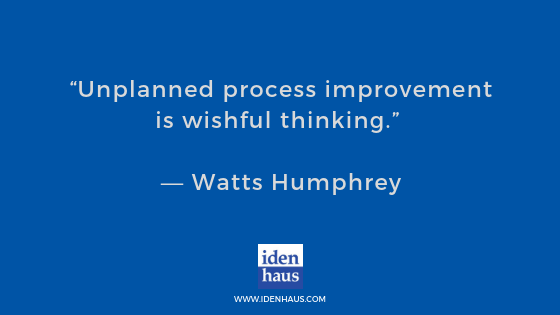
Onboarding workers is one of the most complex processes that impact Identity Management implementations and the end-user experience. Completing the hiring process, creating the user’s IT accounts, setting up payroll and benefits, issuing security badges, and building a workstation are all part of worker onboarding. When there are many activities that have to come together across many departments, is it any wonder that half of all IAM implementations fail the first time? Perhaps not, but there is hope for us with process mapping.
One of the main reasons that IAM implementations fail is a misalignment between the HR processes, supporting user data, and the IAM solution. The best way to avoid this issue is to start with a process analysis and process mapping exercise. The process analysis will help define the worker onboarding process and the additional HR processes that are currently carried out. The analysis also helps identify opportunities to improve the worker experience. More importantly, the exercise of developing process maps for both the current state and future state of onboarding activities will drive alignment between your HR processes, supporting user data, IAM solution, and dependent worker provisioning tasks.
The complexity of the onboarding process makes it difficult to clearly identify specific issues that impact its effectiveness and the end user experience. Not only that, it’s often difficult to identify the underlying problem and then apply that knowledge to build a better process supported by your IAM solution.
Using a process map makes the pathway from candidate to fully provisioned worker more transparent as each step is defined, making it easier to pinpoint problems and propose viable solutions. Process maps also lay bare any assumptions about what is occurring and why, which will help avoid designs that do not address the actual issues.
“Unplanned process improvement is wishful thinking.” – Watts Humphrey
Successful process mapping begins with seeking clarification for the reasons behind each step during the onboarding process. It is important to go beyond the activity itself and understand the purpose of that action. As we’ve written about before, engaging stakeholders is imperative to the success of any IAM project. For process mapping, the key stakeholders to engage are HR, IT, Asset Management, and Physical Security. A useful technique for obtaining more detailed responses when talking to stakeholders is using open questions to drive the discussion.
There are 7 things that every successful process mapping exercise should reveal:
- Waste – Redundant or unnecessary steps and any duplication of effort
- Data flow across the activities
- Bottlenecks and constraints
- Bad variation (e.g. variable time to complete background checks, asset provisioning)
- Opportunities to automate tasks and improve outcomes (consistency, timeliness)
- Understanding the end user experience
- Where further analysis is required
It is important to set up a collaborative environment between HR, IT, and business users early before starting any process mapping exercise. It is essential for teams to feel engaged with the improvement process because it will be up to them to deliver any changes that come out of the analysis. In the end, HR, IT, and the business must come together to implement a new model for managing the user lifecycle. Process mapping offers an opportunity to bring the key stakeholders together and define a new path forward that is reliable, scalable, and effective.
IAM deployments can be complicated, involving people, processes, and technology across the entire business. Join Idenhaus founder Hanno Ekdahl for an interactive and informative webinar on Friday, October 26, 2018, at 12 PM EST. He will provide expert insight on topics like:
-
How to conduct a successful assessment of your processes
-
Identifying process gaps and avoiding common pitfalls
-
Best practices in process alignment for a successful IAM deployment
Click here to register for our upcoming webinar Successfully Integrating HR Processes with Identity Management.
Also, download my digital book now, for free: Reimagining Identity Management: How To Design, Choose And Implement The Right IAM Solution For Your Business.
Follow @Idenhaus on Twitter and subscribe to our biweekly newsletter.
By going to work quickly to solve the most challenging cybersecurity and identity management problems, Idenhaus takes the pain out of securing corporate information and assets for companies that aspire to maximize their potential in this digital age. Click here to contact us







